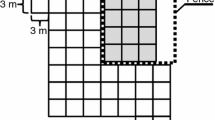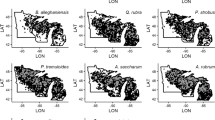Abstract
Browsing of overabundant free-living herbivores often limits the natural as well as artificial regeneration of forest in Central-European Mountains. The aim of the study was to assess the efficiency of the extensive reductions of herbivore populations for protection of forest regeneration in preferred areas. We analysed the relationship between the intensity of shoot browsing and relative density of herbivores in viewpoint of natural regeneration of secondary mountain spruce stands with low proportion of broadleaved trees in Králický Sněžník Reserve (Czech Republic). The distribution of seasonally migrating herbivores was established by counting faecal pellet groups (standing crop method) in growing season. The intensity of browsing of spruce, beech and rowan was assessed using the proportion of browsed shoots on individual tree sapling. Density of red deer was re-counted from the number of pellet groups and it was 15–56 individual/km2. The intensity of spruce browsing was low in the whole area in all seasons. In general, the intensity of rowan and beech shoot browsing was high in the whole area. There were no correlations between deer density and browsing intensity of rowan (browsing was severe in all plots). We conclude that the natural regeneration of attractive trees and shrubs is nearly impossible in habitats where proportion of these food items is too small, even when the density of herbivores is low. Reduction of herbivores density is useful for protecting spruce and other tree species with low preference by herbivores. Forest managers should take into account the high palatability of deciduous tree species and distribution of herbivores on localities. Preference of localities is often based on grasses in the food supply. Regeneration of highly palatable tree species requires both low density of herbivores and sufficient protection of saplings.




Similar content being viewed by others
References
Augustine DJ, DeCalesta D (2003) Defining deer overabundance and threats to forest communities: from individual plants to landscape structure. Ecoscience 10:472–486
Augustine DJ, McNaughton SJ (1998) Ungulate effects on the functional species composition of plant communities: herbivore selectivity and plant tolerance. J Wildl Manage 62:1165–1183
Campbell D, Swanson GM, Sales J (2004) Comparing the precision and cost-effectiveness of faecal pellet group count methods. J Appl Ecol 41:1185–1196
Catt DC, Dugan D, Green RE, Moncrieff R, Moss R, Picozzi N, Summers RW, Tyler GA (1994) Collisions against fences by woodland grouse in Scotland. Forestry 67:105–118
Cote DC, Rooney TP, Tremblay JP, Dussault C, Walter DM (2004) Ecological impact of deer overabundance. Annu Rev Ecol Syst 35:113–147
Danell K, Bergstrom R, Edenius L, Ericsson G (2003) Ungulates as drivers of tree population dynamics at module and genet levels. For Ecol Manage 181:67–76
Gill RMA (1992) A review of damage by mammals in north temperate forests. 3. Impact on trees and forests. Forestry 65:363–388
Heroldová M, Homolka M, Kamler J (2003) Breakage of rowan caused by red deer—an important factor for Sorbeto-Piceetum stand regeneration? For Ecol Manage 181:131–138
Heuze P, Schnitzler A, Klein F (2005) Is browsing the major factor of silver fir decline in the Vosges Mountains of France? For Ecol Manage 217:219–228
Hobbs NT (1996) Modification of ecosystems by ungulates. J Wildl Manage 60:695–713
Hofmann RR (1989) Evolutionary steps of ecophysiological adaptation and diversification of ruminants: a comparative view of their digestive system. Oecologia 78:443–457
Homolka M (1996) Foraging strategy of large herbivores in forest habitats. Folia Zool 45:127–136
Homolka M, Heroldová M (2001) Native red deer and introduced chamois: foraging habits and competition in a subalpine meadow-spruce forest area. Folia Zool 50:89–98
Homolka M, Heroldová M (2003) Impact of large herbivores on mountain forest stands in the Beskydy Mountains. For Ecol Manage 181:119–129
Homolka M, Matouš J (1999) Density and distribution of red deer and chamois in subalpine meadow habitats in the Jeseniky Mountains (Czech Republic). Folia Zool 48:1–10
Igota H, Sakuragi M, Uno H, Kaji K, Kaneko M, Akamatsu R, Maekawa K (2004) Seasonal migration patterns of female sika deer in eastern Hokkaido, Japan. Ecol Res 19:169–178
Kay S (1993) Factors affecting severity of deer browsing damage within coppiced woodlands in the south of England. Biol Conserv 63:217–222
Kuiters AT, Mohren GMJ, Van Wieren SE (1996) Ungulates in temperate forest ecosystems. For Ecol Manage 88:1–5
McInnes PF, Najman RJ, Pastor J, Cohen Y (1992) Effects of moose browsing on vegetation and litter of the boreal forests, Isle Royale, Michigan, USA. Ecology 73:2059–2075
Mitchell B, Rowe JJ, Ratcliffe P, Hinge M (1985) Defecation frequency in roe deer (Capreolus capreolus) in relation to the accumulation rates of faecal deposits. J Zool 207:1–7
Palmer SCF, Truscott AM (2003) Browsing by deer on naturally regenerating Scots pine (Pinus sylvestris L.) and its effects on sapling growth. For Ecol Manage 182:31–47
Partl E, Szinovatz V, Reimoser F, Schweiger-Adler J (2002) Forest restoration and browsing impact by roe deer. For Ecol Manage 159:87–100
Potvin F, Beaupre P, Larise G (2003) The eradication of balsam fir stands by white-tailed deer on Anticosti Island, Quebec: a 150-year process. Ecoscience 10:487–495
Putman RJ (1996) Ungulates in temperate forest ecosystems: perspectives and recommendations for future research. For Ecol Manage 88:205–214
Putman RJ, Moore NP (1998) Impact of deer in lowland Britain on agriculture, forestry and conservation habitats. Mammal Rev 28:141–163
Raspé O, Findlay C, Jacquemart (2000) Sorbus aucuparia L. J Ecol 88:910–930
Reimoser F (2003) Steering impacts of ungulate on temperate forests. J Nat Conserv 10:243–252
Risenhoover KL, Maass SA (1987) The influence of moose on the composition and structure of Isle Royale forests. Can J For Res 17:357–364
Rooney TP, Waller DM (2003) Direct and indirect effects of white-tailed deer in forest ecosystems. For Ecol Manage 181:165–176
Russell FL, Zippin DB, Fowler NL (2001) Effects of white-tailed deer (Odocoileus virginianus) on plants, plant populations and communities: a review. Am Midl Nat 146:1–26
Sage RB, Hollins K, Gregory CL, Woodburn MIA, Carroll JP (2004) Impact of roe deer Capreolus capreolus browsing on understorey vegetation in small farm woodlands. Wildl Biol 10:115–120
Ward JS, Mervosh TL (2008) Strategies to reduce browse damage on eastern white pine (Pinus strobus) in southern New England, USA. For Ecol Manage 255:1559–1567
Welch D, Scott D (1998) Bark-stripping damage by red deer in a Sitka spruce forest in western Scotland. IV. Survival and performance of wounded trees. Forestry 71:225–235
Acknowledgments
This study was supported by the Grant Agency of the Czech Republic, Grant No. 206/03/P134 and by the Czech Ministry of Education, Biodiversity Research Centre, Grant No. LC06073. We thank Miluse Blechova for English linguistic improvement of this manuscript.
Author information
Authors and Affiliations
Corresponding author
Additional information
Communicated by J. Müller.
Rights and permissions
About this article
Cite this article
Kamler, J., Homolka, M., Barančeková, M. et al. Reduction of herbivore density as a tool for reduction of herbivore browsing on palatable tree species. Eur J Forest Res 129, 155–162 (2010). https://doi.org/10.1007/s10342-009-0309-z
Received:
Revised:
Accepted:
Published:
Issue Date:
DOI: https://doi.org/10.1007/s10342-009-0309-z




